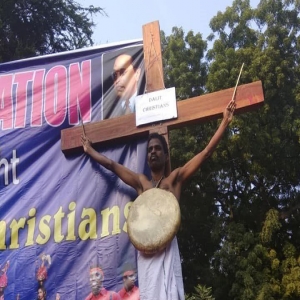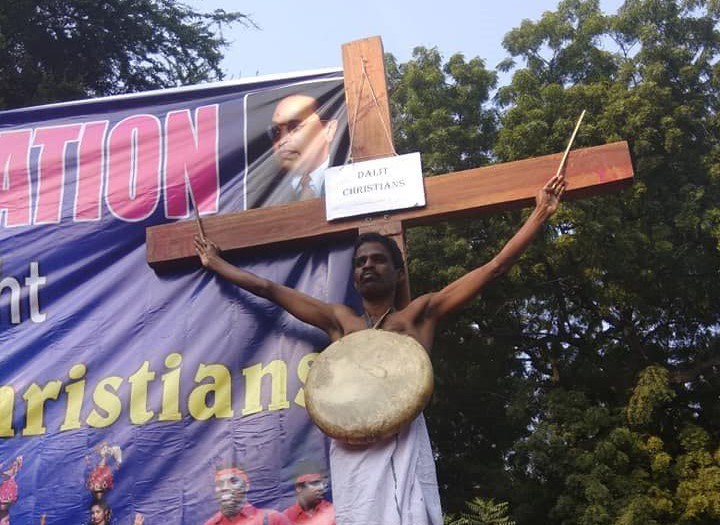
.png) John Dayal
John Dayal

For over seven decades, Dalit Christian voices have risen not just against the state's discriminatory fiat but against the very sanctuaries meant to offer solace.
As a journalist for over half a century and an activist, this writer has chronicled faith's frayed edges in the community's demonstrations against the betrayal of the twin assurances of the mass turning to Christ in the early decades of the 20th century - not for spiritual salvation alone, but for the tangible dignity denied by Hindu varna's iron code.
The caste system in India, deeply rooted in ancient Hindu social structures of varna and jati, divides society into hierarchical groups based essentially on birth and ritual purity, with Dalits (formerly called "untouchables") at the bottom, subjected to severe discrimination, exclusion, and violence across generations and subcontinental geographies.
While the caste system is intrinsically linked to Hinduism, where it is justified through concepts like karma and dharma, it has permeated other religions in India due to historical, social, and cultural influences, leading to caste-like divisions even in faiths that ideologically reject hierarchy.
Sikhism, which emerged as a rejection of caste in the 15th century under Guru Nanak, still sees caste-based practices in India, with Jat Sikhs (landowning upper castes) dominating institutions, while Dalit Sikhs (like Mazhabis or Ravidasis) face segregation in gurdwaras, marriages, and villages, contradicting the faith's core teachings. Dalits have their own Gurudwaras.
Practitioners of these faiths carry their belief in caste and purity even when they migrate to Western or Southeast Asian countries.
Global Abrahamic religions (the words used in India to define Islam and Christianity), which have no concept of caste, practice this "purity" discrimination in their South Asian incarnations, and the practitioners of these faiths carry this trait of discrimination with them when they too migrate to Western countries.
In Islam, practised by about 14% of India's population, caste persists among Indian Muslims through endogamous groups like Ashraf (upper castes), Ajlaf (middle), and Arzal (lower, including Dalit Muslims), with sanitation and manual labour castes facing similar untouchability as Hindu Dalits, despite Islam's emphasis on equality.
Buddhism in India, revived among Dalits through leaders like BR Ambedkar's mass conversions in 1956, theoretically denounces caste, but Neo-Buddhists (often former Dalits) encounter residual caste biases within communities. However, the faith's egalitarian principles have empowered many to challenge Hindu orthodoxy.
Christianity in India, introduced two millennia ago and now comprising about 2.3% of the population, does not doctrinally support caste, yet Dalit Christians — who form a majority of Indian Christians—endure discrimination within churches, such as separate seating, cemeteries, and denial of priestly roles, mirroring societal caste prejudices despite conversions aimed at escaping untouchability.
Dalit Christians, often descendants of lower-caste Hindus who converted seeking dignity and equality, continue to face economic deprivation, social ostracism, and violence, with reports of "hidden apartheid" in both ecclesiastical and secular spheres, undermining the constitutional promise of equality.
The Constitution (Scheduled Castes) Order, 1950—issued by the President under Article 341—originally restricted Scheduled Caste (SC) status and associated affirmative action benefits (such as reservations in education, employment, and politics) to Hindus only, explicitly excluding those who profess other religions.
Amendments to the 1950 Order extended SC status to Sikhs in 1956 and Buddhists in 1990, recognising caste persistence in these faiths, but Christians and Muslims remain excluded, denying Dalit converts in these religions access to protections against discrimination, introducing religious bias in affirmative action and protection of law.
The Indian government's position, as enshrined in the 1950 Order, assumes that caste discrimination is unique to Indic religions (Hinduism, Sikhism, Buddhism), thus barring Dalit Christians and Muslims from SC benefits, a stance criticised as violating religious freedom and equality under Articles 14, 15, and 25 of the Constitution.
This exclusion has sparked decades of protests by Dalit Christians, including nationwide demonstrations in 2025, demanding inclusion in SC lists, with church bodies and human rights groups highlighting how it perpetuates poverty and denies fundamental rights.
In response to advocacy, the government formed a commission in 2022 under the former Chief Justice KG Balakrishnan to review the granting of SC status to Dalit Christians and Muslims. Its tenure was extended again in 2025, indicating ongoing deliberations but no resolution yet, amid opposition from some SC groups fearing the dilution of benefits.
This had, in fact, been covered by the 2004 National Commission, headed by former Chief Justice Ranganath Misra, who had recommended extending affirmative action to Dalit Muslims and Christians as they too suffered similar infirmities as their Hindu, Jain, Buddhist and Sikh sisters and brothers.
On Dalit Christian Sunday in November 2025, protests pulse with renewed fury—black flags in Tamil Nadu's churches, hunger strikes in Delhi's streets, and a national day of prayer that doubled as an indictment.
This is no recent protest. In the 19th century, when Protestant missions became beacons for the oppressed, converts, often derided as "rice Christianity" by upper-caste detractors, spoke of untouchability's daily degradations.
In 1849, a converted robber named Venkayya sparked an "explosion" of baptisms among Telugus in what are now Andhra Pradesh and Telangana.
Babasaheb BR Ambedkar's 1956 Nagpur mass conversion of 5,00,000 Dalits to Buddhism was paralleled by waves of Christian turnings, each a silent referendum on Hinduism's exclusions.
The state's retort was swift and sectarian: the Presidential Order of 1950, under Article 341, barred Christian and Muslim Dalits from Scheduled Caste (SC) benefits—reservations in jobs, education, and politics—deeming caste a "Hindu" affliction alone. This legal sleight-of-hand, extended to Sikhs in 1956 and Buddhists in 1990, left Christian Dalits in a limbo of poverty, their conversions recast as a loss of privilege.
Ironically, this was among the first few amendments to the Indian Constitution, which had been brought out after long consideration before and after the Partition of India in August 1947. In 1950, Dr Ambedkar was still the Law Minister of India, and Pandit Jawaharlal Nehru, a great liberal, was the Prime Minister.
Protests crystallised in the post-Independence era. Since 1950, delegations to Parliament and memoranda to prime ministers have pleaded for inclusion, but the response has been a glacial commission here, a vague assurance there.
The 1980s saw the Dalit Christian Liberation Movement (DCLM) take root, channelling Ambedkarite fury into faith-based advocacy, with its leaders cutting across Christian denominations and also including Muslims from the affected communities, thereby defying the diktats of top leaders and the ulema. A massive march was organised, with Mother Teresa of Calcutta, later a Nobel Laureate, Bharat Ratna and now a Catholic Saint, praying during the launching ceremony of the agitation.
Archbishop Alan de Lastic of Delhi, who was also the president of the Catholic Bishops' Conference of India, led a march and "dharna" at Parliament Street in which more than 500 Bishops and clergy from all denominations participated.
By 2013, the flame blazed brighter: in Delhi, Christian and Muslim Dalits marched en masse, demanding the 1950 Order's repeal. "We are not asking for charity," thundered a protester in a now-iconic chant, "but for the equality our Constitution owes us." The gathering, peaceful yet potent, was met with rough dispersals—batons and barricades underscoring the fragility of minority dissent.
In 2023, a historic Delhi rally drew 22,000 souls, a rainbow of denominations uniting against rising persecution, where Dalit Christians voiced not just quota woes but the "hidden apartheid" within their own folds: segregated cemeteries, barred sacraments, and upper-caste clergy's indifference. Dalit theology, born in these crucibles, emerged as a "protest theology," rejecting marginalisation and reclaiming Christ's preferential option for the poor as a scalpel against ecclesial casteism.
Many Nuns, clergy and lay persons were injured in the police charge, first by water canons and then by batons, at the rally that spilt over from the Jantar Mantar protest grounds to Parliament Street.
These were historical stirrings. A Dalit theologian summed up a 2022 Puducherry sit-in, saying, "Our forefathers crossed the Jordan of caste for freedom, only to find new Pharaohs in the presbytery."
This writer was part of the jury of a public judicial hearing, one of several, organised in South India, which confirmed caste prejudices, especially in the Catholic Church, which still has a woefully tiny number of Dalit Bishops in the Hierarchy. It was only after Pope Francis appointed the first Dalit Cardinal in the Indian Catholic Church.
Just days ago, on November 9, Christians nationwide marked Dalit Liberation Sunday—a poignant ritual of solidarity across denominations, from Kerala's Syro-Malabar rites to Punjab's Protestant halls.
The statistics of exclusion are grim — 70% of Indian Christians are Dalit, yet they hold but 10% of clerical posts.
Failed by the political system, including the Congress, which ruled in coalitions until 2014, barring a break from 1998 to 2004, when the BJP's National Democratic Alliance was in power, the Dalit Christians moved the Supreme Court in multiple writ petitions as Public Interest Litigations. The only development has been the ruling of retaliatory petitions by Hindu groups challenging what they claim are "foreign faiths" indulging in forcible and fraudulent conversions.
This year's protests have been particularly visceral in their locality. In Tamil Nadu's Trichy district, the St. Mary Magdalene Church in Kottapalayam became a flashpoint.
For over a century, Dalit Christians—descendants of Paraiyar labourers—have been ghosts in their own parish: denied chariot-pulling roles in the annual festival, shunned from committees, and even barred from burial grounds. In July, over 200 Dalits staged a hunger strike outside the district collector's office, their emaciated frames a stark tableau against the opulent festival.
Bishop Jeevanandham Amalanathan of the Kumbakonam Diocese, who had previously supported Dalit Christian protests, skipped the car procession organised by the protesters, drawing national headlines and sparking outrage on the social media platform X.
August 11 marked the 75th anniversary of the 1950 Order's iniquity with a "National Day of Prayer and Protest." From Delhi's Jantar Mantar to Kerala's coastal hamlets, thousands rallied under the Catholic Bishops' Conference of India (CBCI), holding placards that read: "Religious Discrimination is Against the Constitution." Interfaith vigils with visible Dalit Muslims marked the occasion, featuring a video message from Cardinal Oswald Gracias, a senior church leader, who declared, "We will not cease until inclusion."
In September, Karnataka's BJP warned of "Dalit backlash" against any softening of SC lists, a veiled threat that chilled advocacy. Punjab's draft sacrilege law, tabled in October, loomed as a noose on free ex
No protest pierces deeper than those turned inward. Dalit Christian leaders cite segregated feasts and denied ordinations. These are not anomalies but symptoms of a church colonised by caste's logic, where Tamil OBC Christians wield influence in the Vatican, silencing Dalit pleas, they allege.
Dalit Christian protests indict a government that, in 2022's Justice Balakrishnan Commission, promised review but delivers delays; a Church that preaches agape yet practices apartheid.